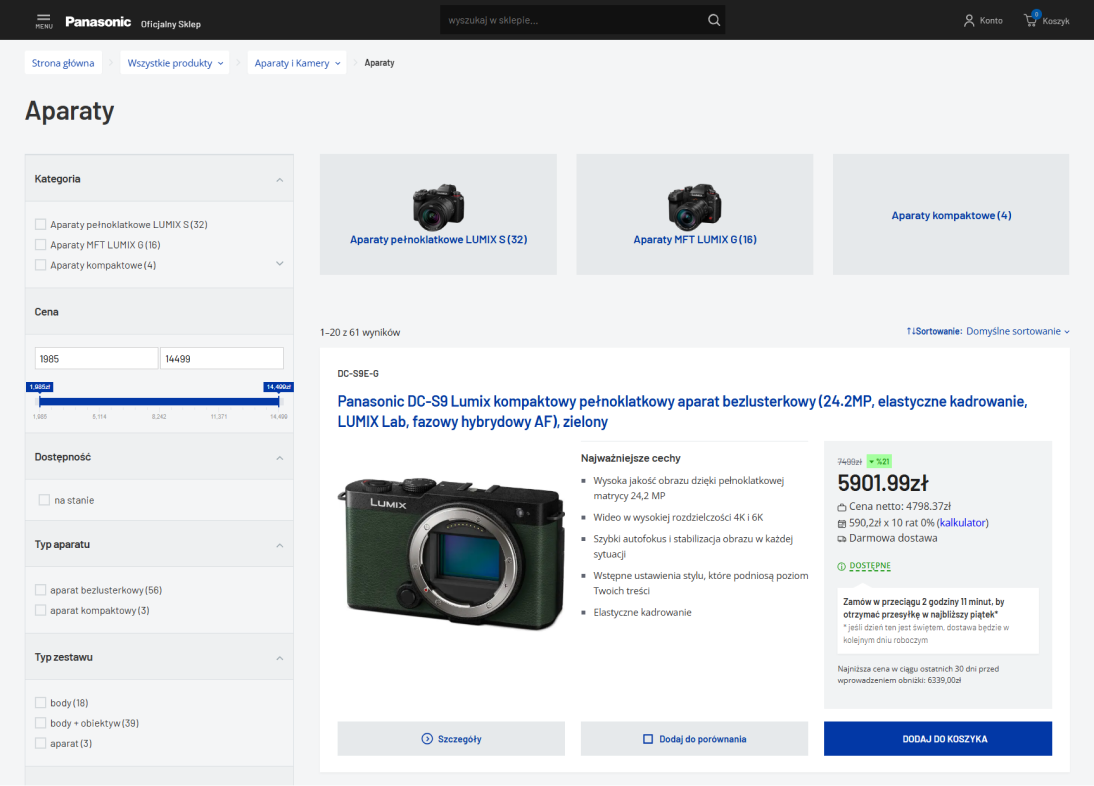Case Study
Panasonic
Building Panasonic’s Scalable E-Commerce Platform for CEE Market Expansion
Last Updated: April 29, 2025
View
Case Study

Client Industry:
eCommerce
Annual Revenue:
$57+ Billion
Project Type:
Global Corporate Website Development Of An E-Commerce Platform for Consumer Electronics and Industrial Solutions
Client Website:
pl.panasonic.com
Company Size:
Corporate
Project Timeline:
Ongoing
Overview
Panasonic aimed to develop a scalable e-commerce platform for its operations in Central and Eastern Europe.
The project focused on creating a cost-effective solution that could easily expand to other countries in the region, enabling local control, direct customer communication, and personalized promotions.
The goal was to establish a robust sales channel that aligns with Panasonic’s business objectives while being efficient in both costs and implementation time.
Challenges
- Need for multiple system integrations.
- Requirement for an affordable platform.
- Quick adaptation to new markets.
- One-month setup target per country.
- Tailored features for local markets.
Results & Benefits
- Established direct sales channel.
- Improved direct communication and marketing.
- More affordable than Western European solutions.
- Enabled swift entry into new markets.
- Empowered teams for local management.
Our Approach
Our team approached the project with a structured process designed to meet Panasonic’s unique needs while ensuring scalability and cost-effectiveness.
The process began with platform selection, where WooCommerce was identified as the optimal solution due to its flexibility and lower costs.
WooCommerce, built on WordPress, provided a familiar ecosystem for content management, making it easier for Panasonic’s local teams to manage their e-commerce operations.
This choice aligned perfectly with Panasonic’s requirements for quick expansion into new markets.
Next was the design and architecture phase.
WPRiders focused on creating a modular architecture that would facilitate easy integration with existing systems such as SAP and PIM.
This design allowed for seamless data flow and efficient updates, ensuring that all components of the e-commerce platform could work together harmoniously.
The architecture was carefully planned to support future growth and adapt to local market needs without requiring extensive overhauls.
The tech stack utilized for this project included:
- WooCommerce: As the core e-commerce platform.
- WordPress: For content management and flexibility.
- Microsoft Dynamics: For streamlining operations and customer management
- Jupiter PIM: For managing product information and updates.
- SAP: For price and inventory management.
- FlixMedia: For rich content integration.
- Eloqua: For customer relationship management and marketing automation.
- Payment Gateways: Country-specific providers for handling transactions.
In the implementation phase, the project was divided into distinct stages, beginning with the development of core functionalities.
This phased approach enabled a faster launch, allowing Panasonic to start selling online quickly while additional features were developed in parallel.
The team prioritized essential integrations and functionalities, ensuring that the platform was operational within the tight one-month timeframe required for initial country rollouts.
During the integration phase, WPRiders developed a modular integration system that connected various services and systems, ensuring that data could flow seamlessly from product management to order processing.
This system included robust error handling and failover mechanisms to maintain high reliability, which was crucial for supporting a smooth customer experience.
Finally, the focus on performance and security was paramount throughout the project.
WPRiders implemented caching strategies and optimization techniques to enhance the platform’s speed and efficiency.
Security measures were established to protect customer data and maintain trust, which is essential in e-commerce environments.
Continuous monitoring and feedback mechanisms were also put in place to facilitate ongoing improvements and ensure the platform could adapt to changing market demands.
Overall, this comprehensive approach ensured that Panasonic’s e-commerce platform was not only effective at launch but also positioned for sustained growth and success in the competitive CEE market.


Gallery
Conclusions
The proposed e-commerce platform for Panasonic provides a solid foundation for future growth in the CEE market. By choosing WooCommerce, Panasonic can capitalize on a cost-effective, flexible, and scalable solution that meets the unique needs of local markets.
The strategic approach laid out ensures that the platform not only addresses immediate business requirements but also positions Panasonic for sustainable long-term success in a competitive landscape.

Have a Similar Project in Mind?
Discover how our expertise can benefit your project











